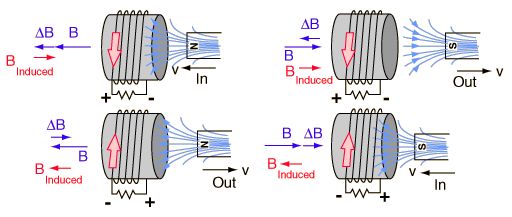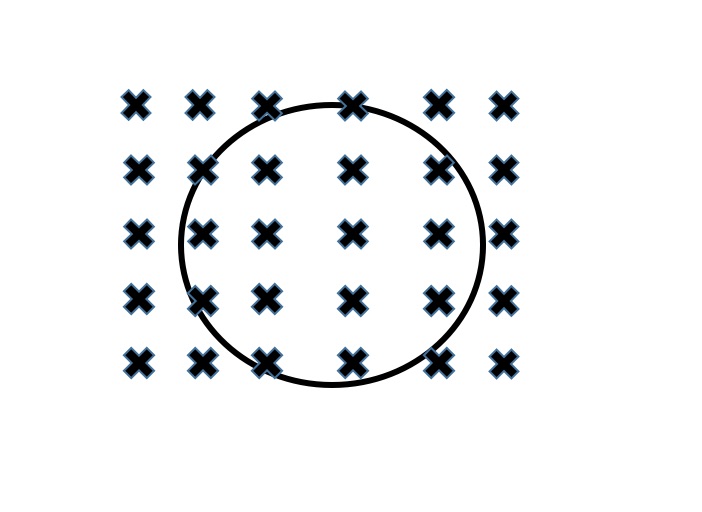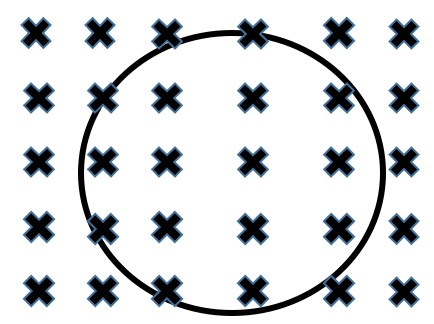Lenz's Law
Claimed by Jenny Zang (Fall 2016)
Edited by Halle Bryan (Fall 2016)
Formulated in 1834, Lenz's Law helps determine the direction of current and the field is creates. When an induced current is generated by a change in magnetic flux, as stated by Farady's Law, the induced current will flow creating its own magnetic field that opposes the magnetic field that created it. Lenz's Law and Faraday's Law of Induction are highly connected, with the negative sign in Faraday's Law showing Lenz's Law. The current direction is important in the upholding of the conservation of energy. Lenz's Law is connected to this conservation and therefore Newton's Third Law as well.
The Main Idea
Lenz's Law makes sure that Faraday's Law follows the conservation of energy as stated by Newton's Third Law. According to Faraday's Law, any change a the magnetic field will cause an induced current (emf). Lenz's Law accounts for the direction of the induced current. The change can be caused by the strength of the magnetic field, the direction of the magnetic field, the position of a circuit, the shape of a circuit, or the orientation of a circuit. The induced magnetic field inside a loop of wires is created to keep the magnetic flux in the loop constant. This graphic displays a basic understanding of how Lenz's Law could function in one example:

A Mathematical Model
Lenz's Law is mathematically modeled as part of Faraday's Law. The negative sign in the equation represents the opposing induced field. [math]\displaystyle{ \epsilon = -{\frac{d\phi}{dt}} }[/math] where [math]\displaystyle{ \epsilon }[/math] is the emf of the system and [math]\displaystyle{ d\phi }[/math] is the change in the magnetic field.
A Computational Model
https://www.youtube.com/watch?v=xxZenoBs2Pg This links to a video by Khan Academy that explains how Lenz's Law works through an example.
https://www.youtube.com/watch?v=Vs3afgStVy4 This links to a video by Grand Illusions that displays Lenz's Law using a magnetic falling down a tube.
Examples
Example 1
Use the right hand rule to find the non-coulombic electric field in the given situations.

Solution
To use the right hand rule: place your thumb in the direction of the [math]\displaystyle{ -dB }[/math], then curl your fingers. The direction in which your fingers curl is the direction of the non-coulombic electric field. The non-coulombic field is represented by the pink arrows.
Simple
A solenoid has current [math]\displaystyle{ I_1 }[/math] flowing around it increasing from 0 to 40A. A plain loop of wire is placed around the solenoid, perpendicular to the axis of the solenoid. An emf is produced, therefore producing an [math]\displaystyle{ I_2 }[/math]. Are [math]\displaystyle{ I_1 }[/math] and [math]\displaystyle{ I_2 }[/math] flowing in the same direction or opposite?
Solution The original current [math]\displaystyle{ I_1 }[/math] produced a magnetic field. In order to maintain the conservation of energy and Newton's Third Law, the magnetic field produced by [math]\displaystyle{ I_2 }[/math] must oppose this field. This is in accordance with Lenz's Law. Therefore, [math]\displaystyle{ I_2 }[/math] must oppose [math]\displaystyle{ I_1 }[/math] in direction.
Middling
The magnetic field in this graphic is decreasing at a rate of 5.0mT/s. What is the direction of the current in the circle of wire?
Solution The current in the circle of wire will produce a magnetic field that needs to supplement the existing diminishing field. This is in accordance with Lenz's Law. Therefore, the magnetic field produced needs to be into the page. Using the right hand rule, to produce a field going into the page the current in the circle of the wire must be in the clockwise direction.
Difficult
Solution
Connectedness
An interesting application for Lenz's Law is to cause rotation to create energy. In an industry setting, Lenz's Law can be applied to electric generators or electric motors. When a current is induced in a generator, the direction of the induced current will flow in opposition of the magnetic field that created it, causing rotation of the generator. And so, the generator needs more mechanical energy.
History
Henrich Friefrich Emil Lenz (1804-1865), a Russian physicist of German origin was born in Dorpat, nowadays Tartu, Estonia. Henrich studied chemistry and physics at the University of Dorpat in 1820 after his secondary education. From 1823 to 1826, he traveled with the navigator, Otto von Kotzebue on his third expedition around the world. During this journey he studied climate conditions, and properties of seawater. After his travels, he worked at the University of St. Petersburg, Russia, where he later became the Dean of Mathematics and Physics from 1840 to 1863. In the year of 1831, he started studying electromagnetism, and soon after in 1835, what is known today as Lenz's Law was created. Lenz died on February 10, 1865, just two days before his 61st birthday, after suffering a stroke, while in Rome.
See also
Since Lenz's Law and Farady's Law go hand in hand, Faraday's Law would be great supplemental information to read about. Newton's Third Law would also be a topic to read on for further understanding why Lenz's Law exists.
Further reading
Faraday's Law [1] Conservation Laws [2]
References
https://nationalmaglab.org/education/magnet-academy/history-of-electricity-magnetism/pioneers/heinrich-friedrich-emil-lenz http://hyperphysics.phy-astr.gsu.edu/hbase/conser.html http://regentsprep.org/regents/physics/phys08/clenslaw/ http://hyperphysics.phy-astr.gsu.edu/hbase/electric/farlaw.html http://farside.ph.utexas.edu/teaching/302l/lectures/node85.html http://www.electrical4u.com/lenz-law-of-electromagnetic-induction/

